Kabuto FF-5V Helmet Review
The Kabuto FF-5V is the latest iteration of the OGK top-of-the-line race helmet.
Don’t let the phrase “race helmet” scare you though, because the FF-5V is also an excellent choice as an all-around street/sport helmet.
It meets the DOT standard and all sizes are Snell M2010 certified.
The FF-5V has outstanding ventilation; in fact, I think it’s the best I’ve ever experienced in a full-face helmet.
And even with all that air flowing through, the helmet is relatively quiet.
The FF-5V also has a very comfortable fit and internal shape for “Neutral” to “Round” shaped heads.
The internal shape is very similar to the (now ancient) OGK FF-3 (review) and also to the modern HJC CL-16 (review), the HJC CL-17 (review pending) and even the Arai RX-Q (review).
The styling of the FF-5V is also an evolution of previous OGK helmets reviewed on webBikeWorld, along with updated and unique features that have improved on one of our favorite helmet series.
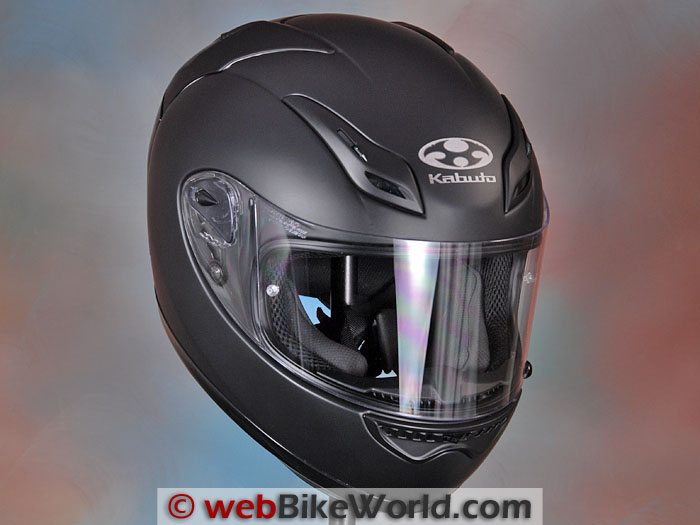
Background
OGK has been building helmets for over 35 years and in July 2006 the company was renamed OGK Kabuto Co. Ltd., from OGK Co. Ltd. to separate the motorcycle helmet line from the bicycle products they produce.
The Kabuto brand name is being emphasized, but webBikeWorld readers will recognize the iconic OGK Kabuto logo that has been carried forward.
The first OGK helmet reviewed on webBikeWorld was the OGK FF-3 (review), sourced from the UK circa 2003.
That helmet was “incredibly light” for its day at 1623 grams (!) in size large. Rick wore the heck out of it for many years, until it was finally retired in 2011.
Next came the OGK FF-4 “Aeroblade” (review), also sourced in the UK, then the OGK FF-5 (review), purchased in Japan. The OGK FF-5 was named the webBikeWorld Motorcycle Helmet of the Yearin 2008 and Rick liked it so much, he bought another.
Now OGK helmets are known by the Kabuto brand and they’re back in the U.S.A., distributed through Western Power Sports. Other new Kabuto helmets include the Aeroblade III, the Kamui and the open-face Avand II.
Note that helmets are no longer sold under the OGK brand; the company is now known as OGK Kabuto, with the emphasis on Kabuto.
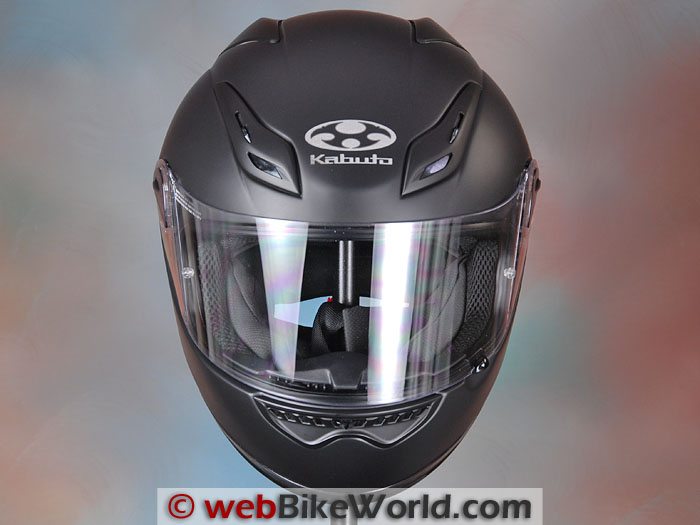
Where to Buy Kabuto FF-5V Helmet
Check Reviews & Prices on Amazon Check Reviews & Prices On RevZillaSee More Motorcycle Helmets, Motorcycle Visor, Motorcycle Intercom
The Kabuto FF-5V: Paint, Graphics and Overall Quality
The OGK FF-5 was known for its array of beautiful graphics and that heritage continues with the new Kabuto FF-5V in the Kousuke Akiyoshi graphics.
Our FF-5V is as far from that as you can get though — it’s basic matte black — a “color” that we first weren’t too sure about but which has grown on us and really suits this helmet’s style.
But matte black does make it difficult to come to an overall conclusion on paint quality for the entire FF-5V lineup. All we can say is that this example is nicely done with no apparent paint or quality issues.
The matte black has a sort of semi-matte or “egg shell” sheen that is not of the “soft” or rubbery type of paint. Instead, it has a fairly “hard” or slick surface feel, which cleans up nicely.
The cut/split lines and gaps on the FF-5V aren’t as tight as the built-like-a-rock Shoei RF-1200 reviewed recently on webBikeWorld and this gives the helmet a less than top-drawer out-of-the-box impression.
It has some gaps in the way the large rear exhaust vent diffuser has been attached to the helmet shell, with the double-sided foam tape peeking out from the split line.
Also, the dark smoke translucent panels that form the low pressure area at the rear of the FF-5V and the covers for the vents work well but don’t give a high-zoot impression and they also have a bit of a “plasticky” feel.
And the “Kabuto” decal at the front of the helmet definitely doesn’t do it justice; how about a nice chrome raised graphic or something to give it a “richer” look?
It’s all a matter of taste though, not functionality and, in fact, the FF-5V has plenty of the latter, as you’ll see.
The rest of the helmet, liner and moving parts are all in good order, although without the buttoned-down, super-solid click-lock feel of your typical Shoei, Arai or even the OGK FF-5, as we remember it.
Again, not that big of a big actually and the RF-1200 kind of sets a new standard in motorcycle helmet solidity with more or less a quantum leap, making all others now seem a bit yesterday in comparison.
But the FF-5V is fighting at almost exactly the same list price as the Shoei, so Kabuto may have to step it up a notch or two. On the other side of the equation, however, the Kabuto FF-5V can be had at a discounted price of about $52.00 less than the RF-1200.
We think that a list price of, say, $379.95 or so would seem more commensurate with its quality, so the discount is about right.
Score: The Kabuto FF-5V gets an “Excellent” rating from us for paint and overall quality. See the Summary Table at the bottom of the page for a description of our rating system.
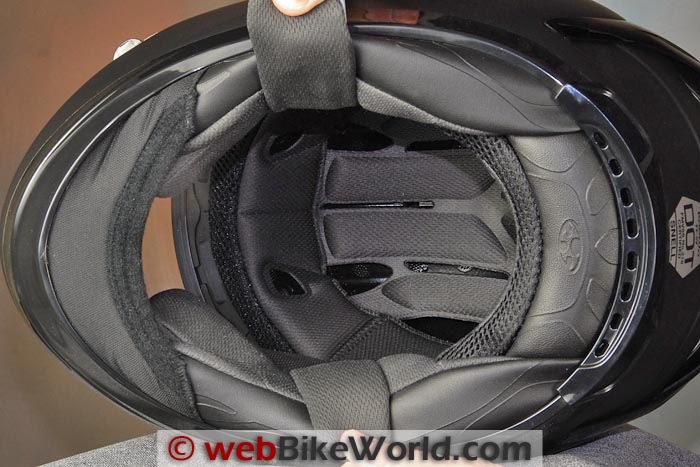
Kabuto FF-5V Fit, Sizing and Internal Shape
Western Powersports, the U.S. distributor, told us that the differences between all of the Japanese and Rest of World Kabuto helmets and U.S. versions are that the U.S. helmets have a “western” head form with an “intermediate” shape, similar to what is sold in Europe and Australia.
The Kabuto helmets sold in Japan and Asia have more of round internal shape.
We think the FF-5V has what we call a “Neutral” to “Slightly Round” internal shape, according to the webBikeWorld Motorcycle Helmet Shapes page.
The helmet comes in a surprisingly generous three shell sizes (XS/S, M/L, XL/XXL) and the liners interchange between each shell size and the cheek pads are also interchangeable for each model (XS through XXL) to custom-fit the helmet.
Spare parts are available and, by the way, the helmet has a five-year warranty with a discount for crash replacement.
As a racing helmet, the shell of the FF-5V is made from the Kabuto “Advanced Composite Technology” or A.C.T. material, which the company says is “a combination of hyper glass fiber and high-strength organic fiber that provides a light weight shell with increased strength.”
Our helmet is a size XL, listed in the helmet as a 60-61 but the Kabuto size charts list it as a 61-62 cm head circumference. We think the helmet label is correct. A size 62 head would probably need the size XXL.
In fact, the FF-5V fits and feels very similar to the OGK FF-3 (review) (size unknown) and it fits almost identical to the size XL HJC CL-16 (review) and the HJC CL-17 in size XL (currently undergoing evaluation for a review).
And the internal shape of the FF-5V is also very similar to Rick’s Arai RX-Q (review) in size XL, although the Arai has just a touch more forehead room, so it’s very slightly narrower in profile.
The bottom line here is that the Kabuto FF-5V has a “generous” fit that should work for many head shapes, other than the very narrow.
The removable cheek pads and upper helmet liner padding are nice and comfy, although maybe a touch more generic and with a fabric that doesn’t quite have the plush feel of the typical Shoei and Arai interiors (the fabric is Coolmax). The padding in the FF-5V also isn’t quite as firm as an Arai, perhaps a matter of preference.
The FF-5V ear pockets are large and generous and the cheek pads have an interesting design that helps eyeglass wearers. We’re not sure if this is by design or not, but Kabuto may want to market it as a special feature.
The cheek pads thin out towards the top, where they meet the upper part of the helmet liner.
Also, there is a small gap between the top of the cheek pads and the helmet liner, with a channel that’s perfect for the temples (sides) of eyeglasses or sunglasses.
We have no problems fitting a pair of straight-temple eyeglasses and sunglasses in the helmet and the combination of the design and the internal shape help to reduce pressure on the sides of the head when eyeglasses are worn.
The shell and liner design and the narrow gasket around the bottom of the helmet mean that it’s fairly easy to install a standard intercom clamp-type mount to the FF-5V also.

Overall, we rate the Kabuto FF-5V as very comfortable, especially for “Neutral” to “Slightly Round” head shapes
More information on helmet fit can be found in the webBikeWorld Motorcycle Helmet FAQ page, along with the chart that lists the helmet weights of webBikeWorld reviewed helmets and also by shape on the webBikeWorld Motorcycle Helmet Shapes page.
Score: The Kabuto FF-5V gets an “Outstanding” rating for comfort and liner materials and padding and a comfortable fit.
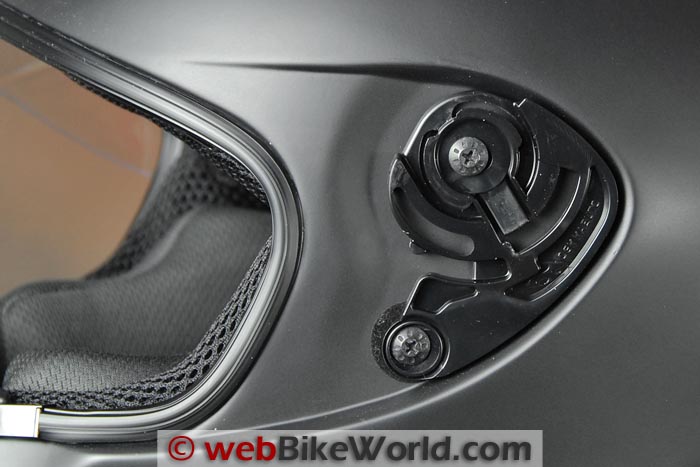
Where to Buy Kabuto FF-5V Helmet
Check Reviews & Prices on Amazon Check Reviews & Prices On RevZillaSee More Motorcycle Helmets, Motorcycle Visor, Motorcycle Intercom
Kabuto FF-5V Face Shield, Eye Port and Visibility
We rate the visibility out the front of the eye port for the FF-5V as better than average in the horizontal plane and perhaps slightly better than average in the vertical plane. This is nearly identical to the Shoei RF-1200 recently reviewed on webBikeWorld.
The Pinlock-equipped face shield measures 2.03 mm on our helmet and it has a snap lock on the lower left-hand side to keep it firmly in place when riding (fast).
The face shield has only three detents, so there’s no small first opening position for city riding or defogging.
Looking at the detents molded into the face shield, it seems like Kabuto could have added an extra “bump” to allow a small first opening position, so we’re not sure why they didn’t. Maybe that’s the concession for a “race” helmet?
The face shield locks tightly in place when the snap is pushed and the full-surround eye port gasket also prevents any water from entering in our “leak down” test.
In fact, the top front and rear vents also close tightly and the design — whether intended or not — seems to prevent water from entering the helmet through those areas also, a bonus for those living in wet climates.
The face shield does not have a VESC-8 label (nor does the Shoei RF-1200 or GT Air) and it’s marked “Not warranted shatterproof” (most helmet face shields are not warranted as shatterproof).
The removal system is very easy to use and illustrated in our video below. Raise the shield, push in the button and the face shield slides out of a “U” shaped channel. To replace it, simply snap it back in.
The optical quality of the face shield is very good and the FF-5V does not have an internal sun visor which it doesn’t need.

Score: The Kabuto FF-5V gets an “Excellent” rating for the overall quality and operation of the face shield.
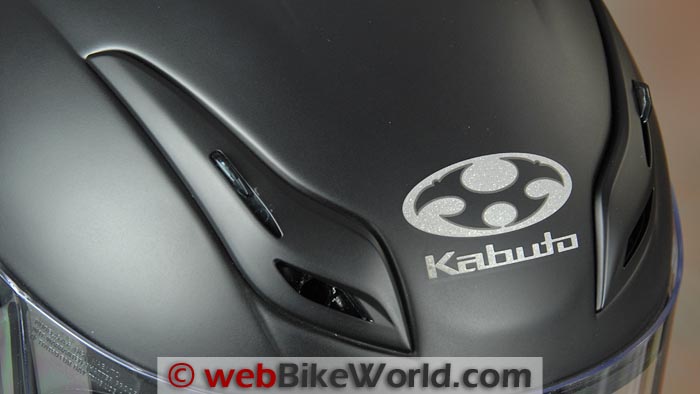
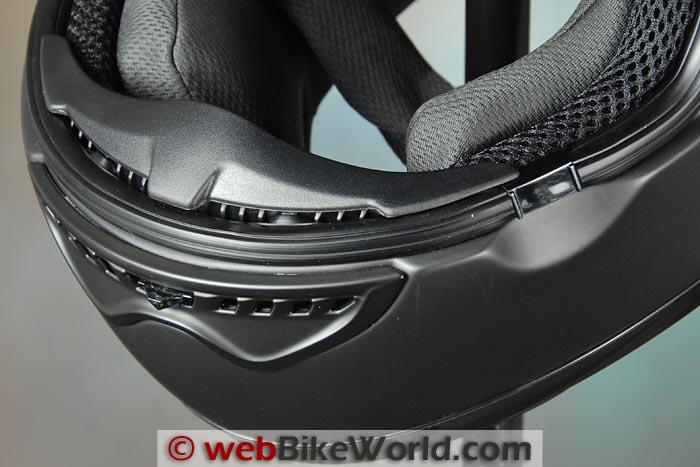
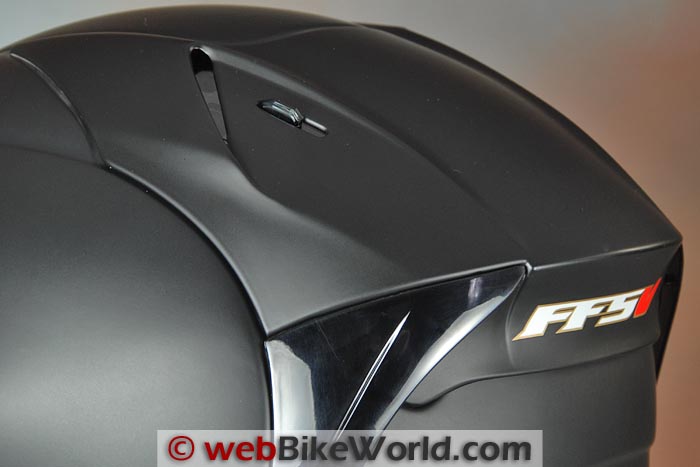
Ventilation and Air Flow
Here’s where it gets interesting; the ventilation system on the Kabuto FF-5V is among the very best we’ve ever experienced.
It just proves once again that it can be done. When you look at the system of vents and covers on the FF-5V, it doesn’t look unusual and, in fact, the system almost looks old-school. Chin vent? Check. Top vents? Check. Exhaust vents? Check…but wait a sec, let’s take a closer look at that one. It tells you something’s different here.
The exhaust diffuser assembly has a bit of an add-on look and it resembles the big motorcycle helmet diffusers of the “boy racer” era we remember from about 8-9 years ago.
Actually, the FF-5V system could almost be called retro but OGK didn’t just slap on an exhaust spoiler assembly for looks, as most of the other manufacturers did (and still do).
OGK helmets have always been known for excellent aerodynamics with superior ventilation that actually works and apparently they’ve been evolving this right along.
Pop open the dark smoke translucent covers on those standard-looking top vents and the air pours into the helmet through big channels down through the EPS and with no liner material covering them — a mistake too many helmet manufacturers make.
You can see it in our video, where a flashlight is used to shine through the vents from the inside. It’s a simple (or maybe not so simple) matter of making sure the air has a direct passage down on to the rider’s head and the FF-5V does it.
Slide open the translucent covers on the exhaust vents and you’ll get the same effect. You can see right down into the helmet, so the air has an unimpeded flow out the back, unlike most helmets with tiny exhaust “vents” that can’t even be seen from the inside. The rear exhaust channels on the FF-5V are huge in comparison.
The entire rear exhaust diffuser system is designed to really pull the air through the helmet via the low pressure area in the back. There’s a full-width slot along the rear of the lip of the spoiler along the top, just under the “FF5V” logo.
This, along with the slots at the side of the helmet under those dark smoke translucent vertical panels on either side at the back, work in harmony to exploit the low pressure area in the rear of the helmet.
The chin vent also looks like your everyday garden variety type too, but snap it open (another dark smoke translucent slider cover) and it pours air through two big square channels in the chin bar (a filter keeps out any critters).
More air flows along the top of the chin bar for defogging.
The system can be felt as soon as you reach, oh, about 20 MPH or so. Why motorcycle racers need such an effective system is a good question; after all, when you’re going 200 KPH, do you really need a hurricane through the helmet? But at 60 KPH, you do and the FF-5V does.
And on top of all that, the helmet is still relatively quiet at speed. You want ventilation in a full-face helmet? The Shoei GT Air (review) and the Kabuto FF-5V are the way to go.
The Shoei is a bit quieter but the Kabuto flows a bit more air that can be directly felt.

Score: The Kabuto FF-5V ventilation system rates an “Outstanding” overall.
Where to Buy Kabuto FF-5V Helmet
Check Reviews & Prices on Amazon Check Reviews & Prices On RevZillaSee More Motorcycle Helmets, Motorcycle Visor, Motorcycle Intercom
Kabuto FF-5V Noise Levels
Overall, the FF-5V is surprisingly quiet, given its outstanding ventilation. There is some noise that can be heard from the top vents, depending on the angle of the head when riding.
But if the internal shape matches your head shape, the sound levels aren’t too bad at all and the ventilation tradeoff is worth it.
Of course, if you’re on a bike with a windscreen that dumps air at the top half of this helmet or any other you may be out of luck. Also, we noted that turning the head one way or another to point the top front vents into the airstream changes the amount of air flowing into the helmet and also the sound levels.
But riding a motorcycle without a windscreen, at street-legal speeds and with the helmet in the clean air, the FF-5V actually seems quieter than average.
The FF-5V, worn back-to-back with the Shoei RF-1200, has none of the low “booming” noise we experienced with the Shoei.
We tried everything to figure out where the noise was coming from on the Shoei without an answer, yet as soon as we put on the Kabuto, the noise disappeared. Same bikes, same day.

Note that our helmet evaluations are a combined effort of several riders over time on different types of motorcycles with and without windscreens.
Evaluators wear correctly fitted, high quality ear plugs (even when evaluating motorcycle intercom systems).
Always protect your hearing when riding a motorcycle. See the wBWEarplug Reviews for more information on choosing and wearing earplugs.
Note also that perceived noise levels will vary, depending on the individual.
Noise can be caused by many factors, including helmet fit, the type of motorcycle and windscreen, wind speed and direction and even the rider’s clothing.
For more information on helmet noise, visit the wBWMotorcycle Helmet Noise page.
Score: The Kabuto FF-5V gets an “Excellent” rating for noise control, which is amazing, considering the efficiency of the ventilation system.
an “Excellent” rating for noise control, which is amazing, considering the efficiency of the ventilation system.
Helmet Weight
Our Kabuto FF-5V in size XL with the matte black finish weighs 1734 grams (3 lbs., 13-1/8 oz.), which is pretty good considering it’s a size XL and it’s also Snell M2010 certified.
Other helmets for comparison include the Shoei GT Air (review) in size XL at 1757 grams and the DOT version of the SCHUBERTH S2 (review) in size XL at 1712 grams. Neither of those helmets have the Snell certification.
The Shoei RF-1100 (review) does, and in size XL it weighed 1746 grams. The HJC CL-16 (review) in size XL weighs 1702 grams and it is also Snell M2010 certified.
So the Kabuto FF-5V weight feels about average and the excellent aerodynamics help when riding also.
Note also that all of the helmets reviewed on webBikeWorld have been weighed and the weights are available on the wBWMotorcycle Helmet Weights page, along with a chart that lists the helmets by weight and shape on the wBWMotorcycle Helmet Shapes page.
Score: The Kabuto FF-5V gets an “Excellent” rating for its weight and good balance.
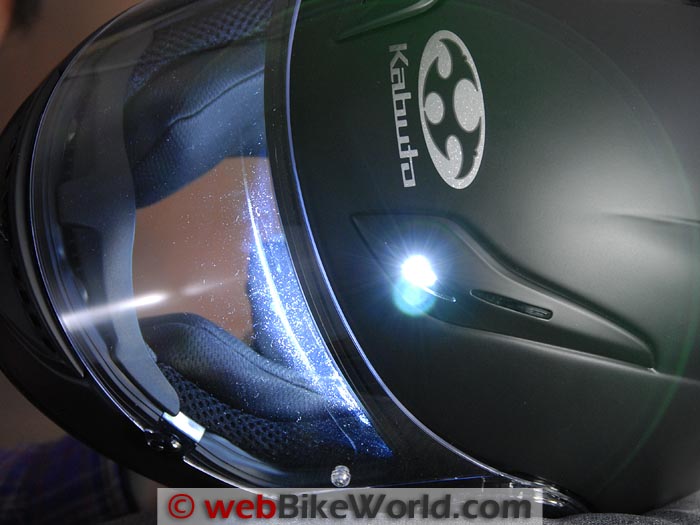
Miscellaneous
The Kabuto FF-5V has a double D-ring chin strap retainer with comfortable and removable padding underneath. Kabuto provides a five year warranty (from date of purchase) on their helmets and they have a discounted program for replacements if the helmet was in a crash.
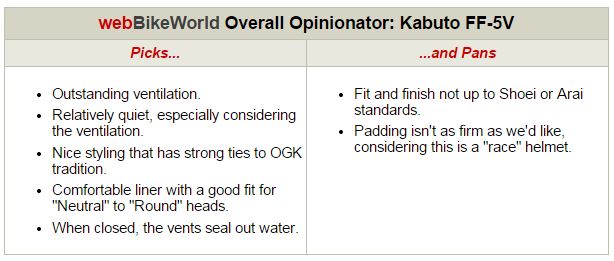
Conclusion
The new Kabuto FF-5V has a lot of things going for it and OGK fans will definitely want one. The combination of the DOT and Snell M2010 certification, along with the outstanding ventilation, comfort and good looks, make the FF-5V a real contender.
The helmet can be found at a street price of around $389.00 for the solid colors and at $432.00 (street), even the Akiyoshi graphic version is reasonably priced.
Finding a full-face helmet with these specs and with this amount of ventilation is rare indeed, so the Kabuto FF-5V should definitely be on your short list.
Where to Buy Kabuto FF-5V Helmet
Check Reviews & Prices on Amazon Check Reviews & Prices On RevZillaSee More Motorcycle Helmets, Motorcycle Visor, Motorcycle Intercom
Owner Comments and Feedback
See details on submitting comments.
From “N.C.” (June 2015): “I have read your report on the Kabuto helmet and while i agree it’s light and air vents work, etc., I must have received a duffer.
I am currently demonstrating one for evaluation purposes and my findings are the chin vent rattles with my touring windshield on my FZ1 Fazer.
Also the Pinlock is not a good fit, as there is a gap of 5-10mm at the uppermost between the Pinlock and visor seal at the top of the helmet, thus covering the rider’s view of the road.
Also, the visor does not open far enough — kinda half-hearted. I would prefer another notch so the visor opened up more.
Apart from that, it’s a cracking helmet if these issues were addressed.
Rick’s Reply: I’m not a big fan of Pinlock inserts, especially when self-installed. They never cover the full face shield sight area and you end up seeing the edge all the way around. Fortunately, the weather here is such that we rarely need any anti-fogging gizmos so I’m lucky I guess…
From “J.B.” (June 2014): “I ordered an FF-5V, and recently received it. I really like the helmet and it’s features. I echo the comments that this is a good helmet for people that wear glasses. The design of the cheek pads and liner make this the easiest helmet for wearing glasses.
Unfortunately, the shape is just too round for my head, and I don’t think of myself as unusually long headed. Even so, the helmet was pressing hard on my forehead and I will have to send the helmet back. Keep that in mind.”
From “W” (November 2013): “The ‘eyeglasses seating’ of the FF-5V is by design and this function was first used on the OGK FF-R III (this model has not been sold in USA or Europe). This function been design in the many models of OGK like Aeroblade III.
The two holes in the liner is the new improvement that is shown on the later FF-5V.
And “KABUTO” in Japanese ![]() means “helmet” that is the head protection of samurai.
means “helmet” that is the head protection of samurai.
P.S. Here is the OGK FF-R III (Japan).”
From “A.C.” (November 2013): “A little background. Motorcycle is a 2007 Honda CBR 600RR. The first helmet I purchased was an Arai Corsair RX7. Second, the Bell Cerwinski Carbon. Lastly, the OGK Kabuto FF5 Akiyoshi-GP direct from Japan.
With that in mind, the FF5 is what I frequently select to wear to a track day or on my 42 mile one way commute.
The reason for my multiple purchases was in search for the most aerodynamic helmet. The effect of the “bobble head” from the Arai compared to the OGK is night and day. OGK being the least amount of the effect.
Even with the aerodynamics of the Bell helmet there is still a noticeable difference comparing it with the OGK. Riding above the windscreen, while wearing the OGK, there is minimal effect of the wind while performing a shoulder check.
I personally don’t feel the push of the wind on the side of the OGK compared to when I wear the other 2 brands. At high speed the Bell does feel more stable but overall, having to perform a shoulder check, the OGK would be my choice. With the new FF5-V, I am definitely curious about the difference in weight and how it personally performs.
Since the FF5 I own was direct from Japan, it does not meet U.S. standards, and would be slightly lower in weight. Would I purchase the FF5-V, yes. Unfortunately, the next helmet I am looking to purchase is the AGV Pista GP to experience the aerodynamics that it claims.”
Other WebBikeWorld Helmet Posts

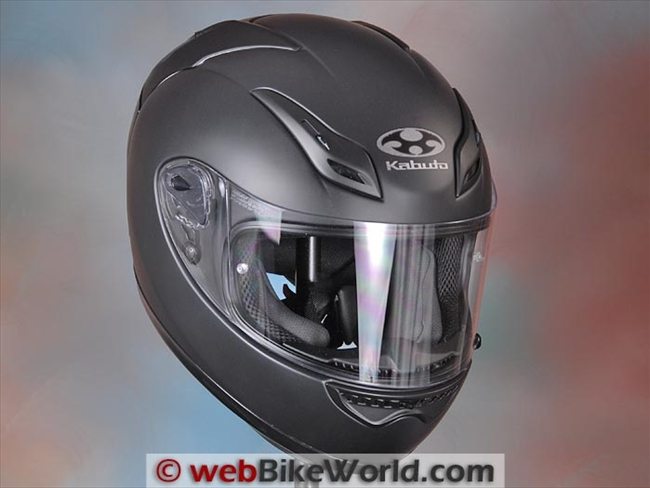


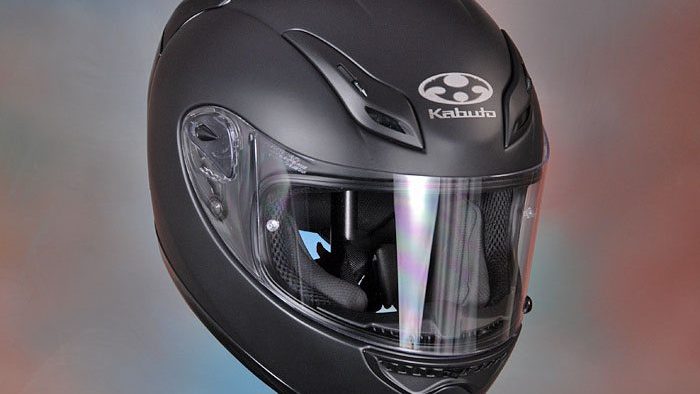
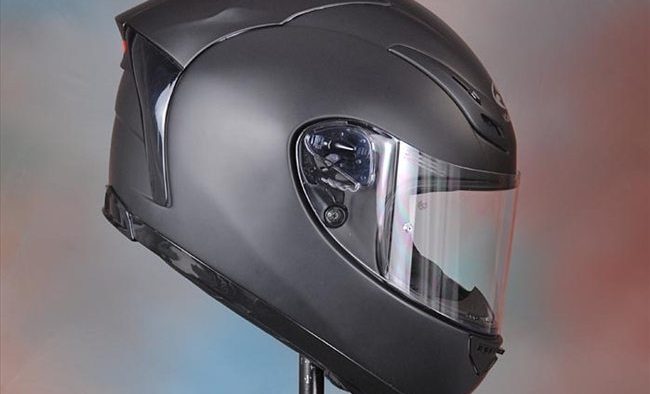
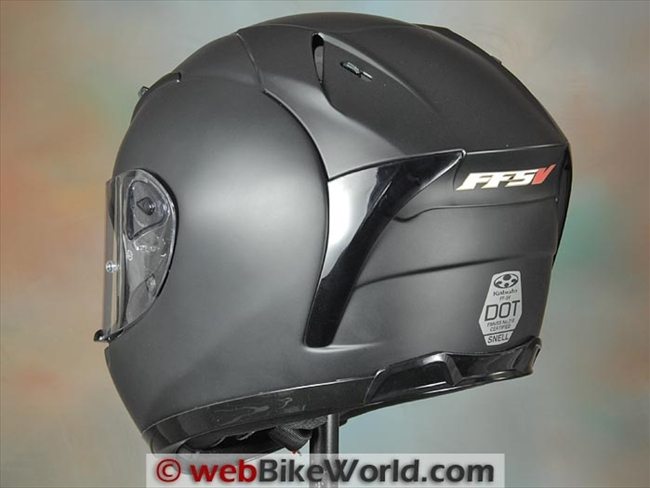
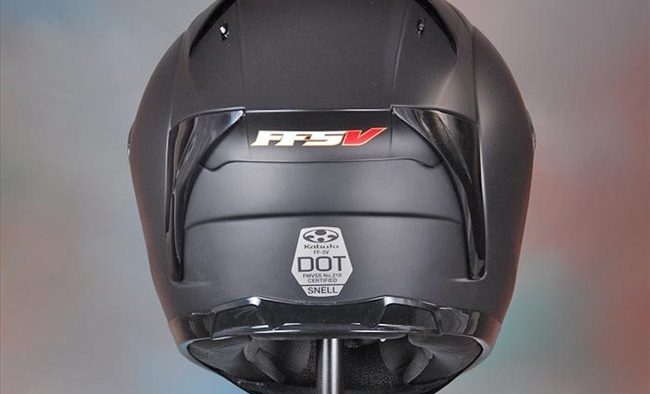
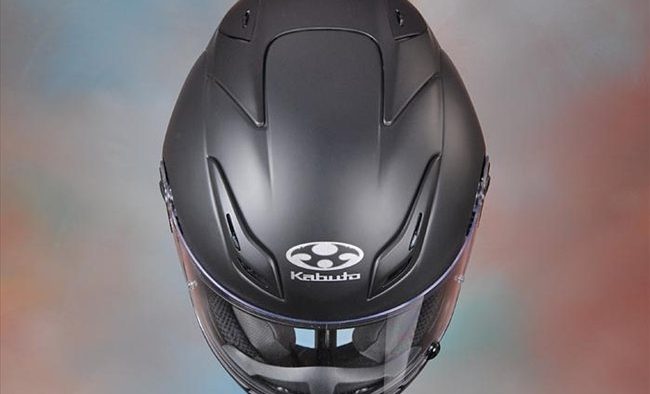
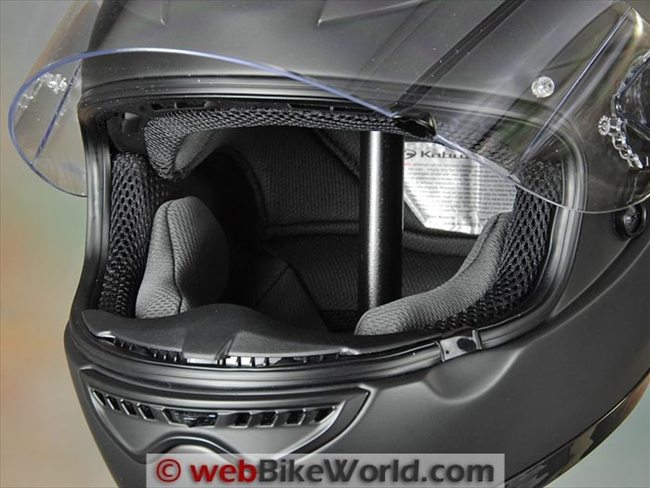
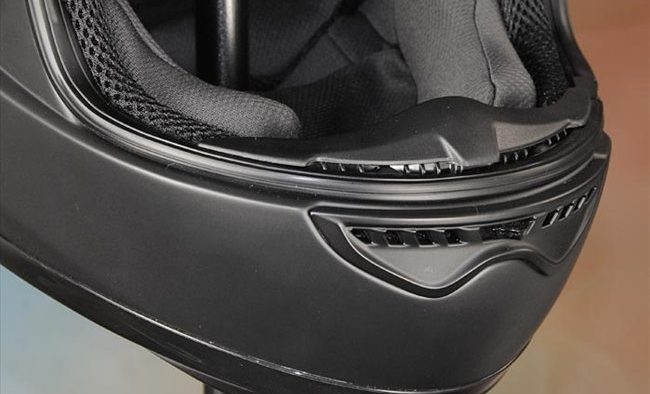
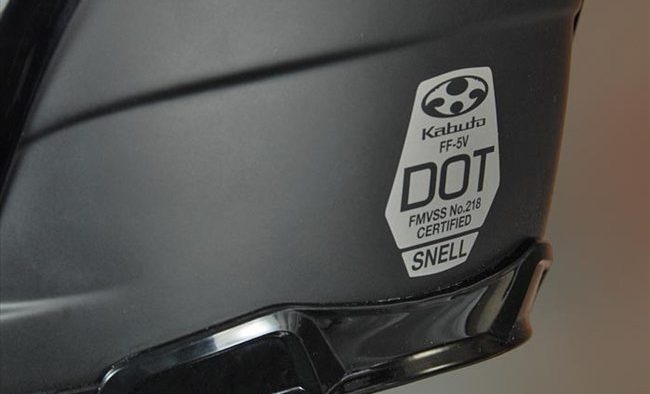
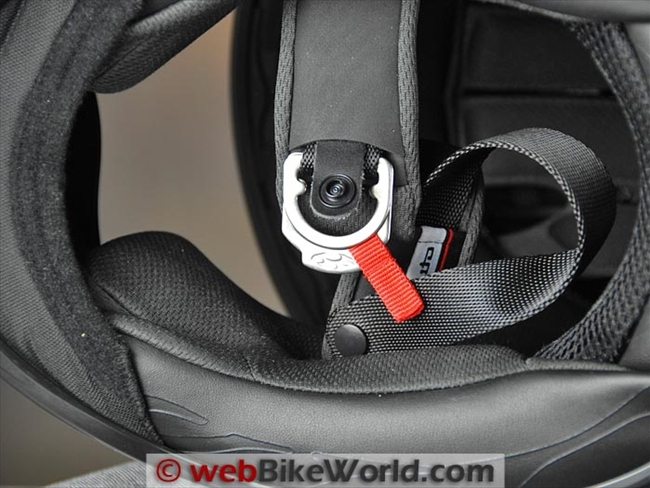
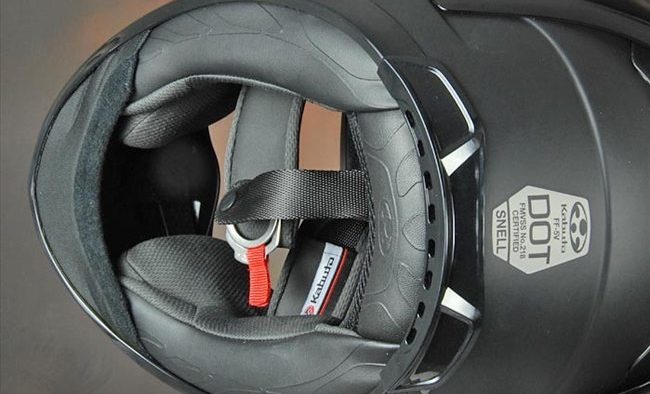


No Comment